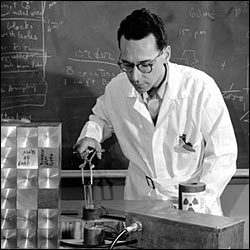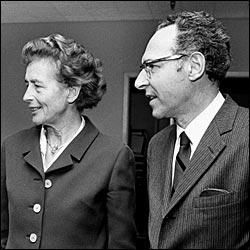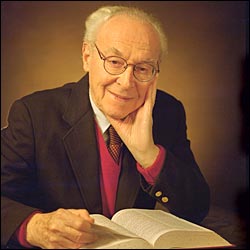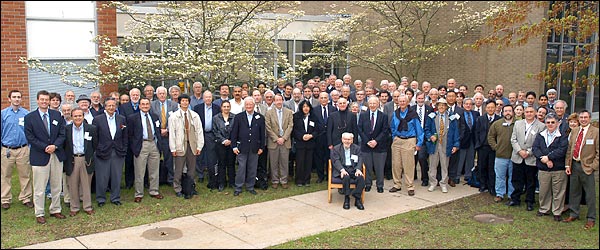Former Lab Director Maurice Goldhaber Turns 100
April 18, 2011

Maurice Goldhaber, 1959
Today, April 18, BNL celebrates the 100th birthday of Distinguished Scientist Emeritus Maurice Goldhaber, a highly honored physicist and former BNL Director whose long and extremely productive career has won him many awards, including the Tom W. Bonner Prize in Nuclear Physics in 1971, the J. Robert Oppenheimer Memorial Prize in 1982, the National Medal of Science in 1983, the Wolf Prize in Physics in 1991, and the Enrico Fermi Award in 1999.
Scientific Contributions
Born in Austria, Goldhaber earned his Ph.D. in physics at the University of Cambridge in 1936. Two years earlier, in 1934, with James Chadwick from the Cavendish Laboratory at Cambridge, he had been the first to measure accurately the mass of the subatomic particle known as the neutron, showing that it was not a compound of a proton and an electron as was believed at the time, but a new particle.

Gertrude and Maurice Goldhaber, 1969
In 1938, Goldhaber joined the faculty of the University of Illinois. In 1950, he and his wife, nuclear physicist Gertrude Scharff-Goldhaber, moved to BNL. He was Physics Department Chair in 1960-61 and Laboratory Director from 1961 to 1973. For their separate scientific contributions, both he and Scharff-Goldhaber were elected members of the National Academy of Sciences and Fellows of the American Academy of Arts & Sciences, the American Association for the Advancement of Science, and the American Physical Society, of which Goldhaber was president in 1982.
Goldhaber’s research in the fields of nuclear physics and fundamental particles covers experiment, systematics, technique, and theory. In addition to measuring the mass of the neutron, he contributed to the discovery of the nuclear photo-effect, the role of spin in nuclear reactions, observing the helicity of the neutrino, and a wide variety of physics research that has supported the standard model.
‘Goldhaberisms’
Although he retired in 1985, Goldhaber continued his research at the Lab for many years. To those who saw him working almost daily, he sometimes joked, “I have no time to age.” Friends expected and enjoyed his “Goldhaberisms.” One example: while on an experiment on proton decay, which would indicate the end of all matter, he said of the proton: “May it live forever — but if it dies, let it die in our arms.”

Maurice Goldhaber, 1999
90th Birthday Celebration, Brookhaven Lectures
Ten years ago, hundreds of BNLers celebrated Goldhaber’s 90th birthday with a symposium, reception, and dinner held in Berkner Hall on July 26. Four years later, Goldhaber marked the beginning of BNL’s “World Year of Physics 2005” celebration with his talk on “The Role of Empirical Rules in Predicting Directions in Science,” which he gave as the 400th Brookhaven Lecture, on January 19, 2005. The Brookhaven Lecture Series was started by Scharff-Goldhaber, who gave the 100th lecture on March 17, 1971. Goldhaber had presented the 11th, 200th, and 300th talks on November 16, 1961; May 18, 1983; and November 2, 1994, respectively — to packed and appreciative audiences.
‘Neutron Helicity at 50’ Symposium
Another red-letter date in Lab history was May 2, 2008, when a symposium, “Neutrino Helicity at 50,” filled the Physics Large Seminar Room with enthusiastic attendees celebrating the half-century-old Goldhaber-Grodzins-Sunyar experiment on neutrino helicity, renowned as an landmark among elegant table-top experiments. Among the many distinguished attendees were Goldhaber; Lee Grodzins, Massachusetts Institute of Technology Professor of Physics Emeritus, and ThermoFisher Scientific; and members of the Andrew Sunyar family. The symposium was held first to look back at the experiment, which proved that the neutrino particle, at that time little known, had “left-handed” spin, or helicity — and also, to discuss the impact this discovery had on particle physics. In addition, the symposium examined some of the current worldwide activities in neutrino physics and the future prospects for the field.

Attendees at BNL’s 2008 symposium on “Neutrino Helicity at 50: A Celebration of the Goldhaber-Grodzins-Sunyar Experiment”
Fellowships, Prizes in Goldhaber’s Honor
Goldhaber’s impact on fellow scientists and scientific research has been outstanding in many ways, among others, the scholarships given in his honor. In 2001, BNL honored both Goldhabers by creating annual Gertrude and Maurice Goldhaber Distinguished Postdoctoral Fellowships. Many of the Fellows have become staff members, and some moved on to tenured positions at universities and at BNL. More recently, in 2009, Magdalene College, Cambridge University, England, expanded the number of its “named” prizes by the Maurice Goldhaber Prize for Natural Sciences or Mathematics, in honor of alumnus Maurice Goldhaber. This annual prize, awarded to a student offering a distinguished performance in experimental or theoretical physics or mathematics, commemorates Goldhaber’s association with the college as a Ph.D. student and subsequently as the Kingsley Bye Fellow, and “recognizes Goldhaber’s eminent academic career in nuclear and particle physics.”
Birthday Wishes to Maurice
From Sam Aronson, BNL
We’ll celebrate a wonderful milestone on Monday, April 18 — the 100th birthday of former BNL Director Maurice Goldhaber, a Distinguished Scientist Emeritus whose outstanding contributions to science and to Brookhaven Lab have been honored throughout his career. He is also a valued friend of many, known for his sparkling wit and appreciated for his courtesy to all. Happy birthday, Maurice, from all of us.
From Nicholas Samios, BNL
Maurice Goldhaber is one of the great physicists of the twentieth century. His physics interests are global, from the neutron to the periodic table of nuclei, to the neutrino and all its complexity and then back to the stability of the proton. He is a human physics google. His essence can be encapsulated by his elegant proposition for measuring the helicity of the neutrino, accomplished with A.W. Sunyar and L. Grodzins. It required his encyclopedic knowledge of esoteric nuclei and complete command of the complex physics involved. Without Maurice, it may not have been done even up to today — a most productive and imaginative physicist.
From Peter Bond, BNL
Maurice: I fondly recall our various interactions over the years which began with my visit to BNL in 1972 and your graciously taking me to dinner with Trudy, the Sunyars and the Sprouses at the Bellport Inn. While in the early years we didn’t have many occasions to talk, I began to learn about what an extraordinary scientist you were. One of the greatest compliments I heard about your science was from Nobel Prize recipient Georges Charpak, who described the neutrino helicity experiment as the most beautiful experiment he knew.
Perhaps as impressive to me was your broad knowledge of science in many fields that allowed you to ask penetrating questions and to come up with creative new ideas in many of those areas. Of course, coupled to your continual creative ideas were your famous quips — one I have come to particularly appreciate is “Physics teaches old things to new people.”
As a person who is fascinated with history, I have greatly enjoyed your reminiscences of your interactions with the physics greats of the early 20th century. Your talks about that era and our chats in recent years have been highlights for me.
From BNLer David Alburger
After I arrived at the Lab in 1948 my first job was to build a lens-type magnetic beta-ray spectrometer. One of the first papers using that device was on “Isomerism in Pb204” authored by Sunyar, Alburger, Friedlander, M. Goldhaber, and G. Scharff-Goldhaber. Later, just before I left in 1952 on an NSF Fellowship to Sweden, you suggested a problem with a 7-hour isomer in molybdenum whose decay scheme was understood, but its mass was not known. The very first problem that I did at the Nobel Institute of Physics with Sigvard Thulin was to make a source of the isomer and put it into Thulin’s mass spectrometer. It immediately gave the answer. My first letter back to BNL had a 2-word text which read ‘ Dear Maurice — Definitely Mo-93 Sincerely, David.’
Subsequent years were occupied with research using the 3.5-MV and Tandem Van de Graaffs. But with the small machine gone and the Tandems now used for RHIC injection, I have now returned to a problem in your old field of isomerism. Dick Sutter and I have been working for several years on the 2-gamma decay of the 662-keV isomer in 137Ba following the beta decay of 137Cs. The experiment is going well. We are continuing to take data and will eventually publish.
From Elliot Leader of Imperial College London
My first visit to Brookhaven was in the summer of 1964. It was at the end of my first year as a postdoc at Berkeley. It was for me a most extraordinary summer. The Lab was packed with “famous names.” This was one of the many great achievements of Maurice: to create an atmosphere which attracted to the Lab some of the most eminent physicists of the time: Beg, Lee, Pais, Schwartz, Steinberger, Wick…But even more important from my point of view was the effect of Maurice’s personality, his charm, humour, openness, and enthusiasm, which created a very relaxed and friendly atmosphere in the Lab and which somehow rubbed off onto the eminent visitors, so that they became approachable and helpful, even towards such a lowly being as a first-year postdoc. I had a wonderful interaction with Beg and Pais.
Over the years I returned many times to Brookhaven. There were lots of meetings on the beach with Maurice and Trudy and a host of visitors from far afield. Since then, I’ve been back to Brookhaven a few times and have marveled at Maurice’s energy and enthusiasm for physics, his flow of interesting ideas and suggestions, and his never-failing warmth, charm, and hospitality. Maurice is a supreme example of a wonderful human being.
From Eena-Mai Franz, BNL retiree
A warm ‘Happy Birthday’ greeting from another well-wisher who remembers the liveliness of informal beach sessions with Trudy and Maurice Goldhaber and the friendly atmosphere at parties they hosted or attended as guests.
From Jogesh Pati, Professor Emeritus, University of Maryland
Dear Maurice: I learnt with great pleasure that you will reach the golden age of 100 on April 18. Heartiest congratulations for reaching this milestone, crowned by your truly major contributions to our field, of a permanent nature! Among these is your ingenious experiment determining the helicity of the neutrino, which has been of crucial significance to modern developments in particle physics. Equally impressive (for me) are your pioneering efforts in the search for proton decay, starting with your observation of the lower limit of 1016 years for proton lifetime based simply on our own longevity. I remember with pleasure my discussions with you on several occasions on the need for improved searches for proton decay, starting in the summer of 1973 at BNL, when unified theories provided a strong motivation for instability of the proton. While this matter still remains to be settled, your enquiring spirit will continue to provide a guide and inspiration for the younger generations to probe into the unknown.
On the occasion of your forthcoming birthday, I would like to wish you every happiness, good health and peace for all the years to come.
2011-2301 | INT/EXT | Newsroom









